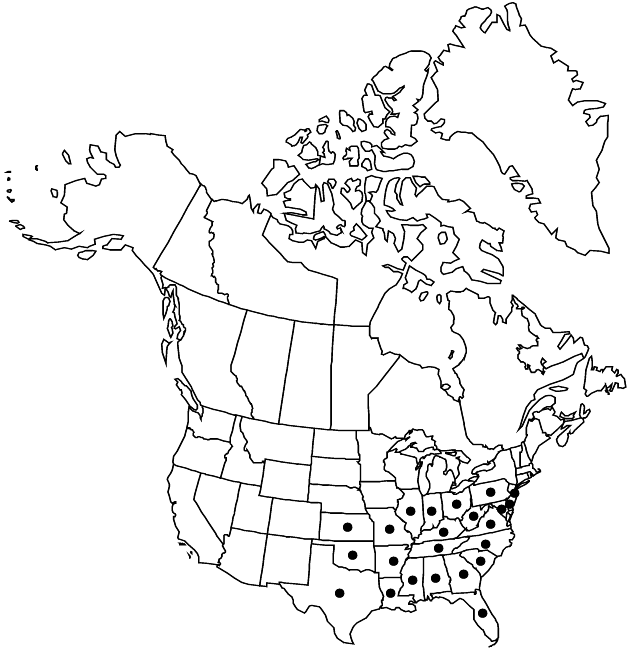Difference between revisions of "Pluchea camphorata"
in A. P. de Candolle and A. L. P. P. de Candolle, Prodr. 5: 452. 1836.
FNA>Volume Importer |
imported>Volume Importer |
||
| (6 intermediate revisions by 2 users not shown) | |||
| Line 1: | Line 1: | ||
{{Treatment/ID | {{Treatment/ID | ||
|accepted_name=Pluchea camphorata | |accepted_name=Pluchea camphorata | ||
| − | |accepted_authority=(Linnaeus) | + | |accepted_authority=(Linnaeus) de Candolle |
|publications={{Treatment/Publication | |publications={{Treatment/Publication | ||
|title=in A. P. de Candolle and A. L. P. P. de Candolle, Prodr. | |title=in A. P. de Candolle and A. L. P. P. de Candolle, Prodr. | ||
| Line 8: | Line 8: | ||
}} | }} | ||
|common_names=Plowman’s-wort | |common_names=Plowman’s-wort | ||
| − | |basionyms={{Treatment/ID/ | + | |special_status={{Treatment/ID/Special_status |
| + | |code=E | ||
| + | |label=Endemic | ||
| + | }} | ||
| + | |basionyms={{Treatment/ID/Basionym | ||
|name=Erigeron camphoratus | |name=Erigeron camphoratus | ||
|authority=Linnaeus | |authority=Linnaeus | ||
| + | |rank=species | ||
| + | |publication_title=Sp. Pl. | ||
| + | |publication_place=2: 864. 1753 | ||
}} | }} | ||
|synonyms= | |synonyms= | ||
| Line 27: | Line 34: | ||
|elevation=0–30 m | |elevation=0–30 m | ||
|distribution=Ala.;Ark.;Del.;Fla.;Ga.;Ill.;Ind.;Kans.;Ky.;La.;Md.;Miss.;Mo.;N.J.;N.C.;Ohio;Okla.;Pa.;S.C.;Tenn.;Tex.;Va.;W.Va. | |distribution=Ala.;Ark.;Del.;Fla.;Ga.;Ill.;Ind.;Kans.;Ky.;La.;Md.;Miss.;Mo.;N.J.;N.C.;Ohio;Okla.;Pa.;S.C.;Tenn.;Tex.;Va.;W.Va. | ||
| − | |discussion=<p>Pluchea camphorata is similar to P. odorata and rarely may hybridize with it. In P. camphorata, the phyllaries of the inner 2–3 series are thin and nearly translucent, lanceolate, and more than twice as long as deltate-ovate phyllaries of the outer series. The inner may be glandular but they are otherwise glabrous, prominently different in vestiture from the outer. The phyllaries of P. odorata are more strongly graduated and the inner are glandular and also clearly puberulent as well.</p> | + | |discussion=<p><i>Pluchea camphorata</i> is similar to <i>P. odorata</i> and rarely may hybridize with it. In <i>P. camphorata</i>, the phyllaries of the inner 2–3 series are thin and nearly translucent, lanceolate, and more than twice as long as deltate-ovate phyllaries of the outer series. The inner may be glandular but they are otherwise glabrous, prominently different in vestiture from the outer. The phyllaries of <i>P. odorata</i> are more strongly graduated and the inner are glandular and also clearly puberulent as well.</p> |
|tables= | |tables= | ||
|references= | |references= | ||
| Line 36: | Line 43: | ||
-->{{#Taxon: | -->{{#Taxon: | ||
name=Pluchea camphorata | name=Pluchea camphorata | ||
| − | + | |authority=(Linnaeus) de Candolle | |
| − | |authority=(Linnaeus) | ||
|rank=species | |rank=species | ||
|parent rank=genus | |parent rank=genus | ||
| Line 50: | Line 56: | ||
|publication title=in A. P. de Candolle and A. L. P. P. de Candolle, Prodr. | |publication title=in A. P. de Candolle and A. L. P. P. de Candolle, Prodr. | ||
|publication year=1836 | |publication year=1836 | ||
| − | |special status= | + | |special status=Endemic |
| − | |source xml=https:// | + | |source xml=https://bitbucket.org/aafc-mbb/fna-data-curation/src/2e0870ddd59836b60bcf96646a41e87ea5a5943a/coarse_grained_fna_xml/V19-20-21/V19_807.xml |
|tribe=Asteraceae tribe Plucheeae | |tribe=Asteraceae tribe Plucheeae | ||
|genus=Pluchea | |genus=Pluchea | ||
Latest revision as of 20:56, 5 November 2020
Annuals or perennials, 50–200+ cm; fibrous-rooted. Stems minutely puberulent and sessile-glandular, usually also closely arachnose (hairs appressed). Leaves petiolate (petioles 10–20 mm); blades elliptic to oblong-elliptic, 6–15 × 3–7 cm, margins dentate-serrate or entire, faces glandular-puberulent or puberulent and sessile-glandular. Heads in paniculiform arrays (of rounded-convex, corymbiform clusters terminating branches from distal nodes, arrays usually resulting from axillary, strongly ascending, bracteate branches, the central axis longest and first to flower and, rarely, the only component of an array). Involucres campanulate, 4–6 × 3–4 mm. Phyllaries usually cream, sometimes purplish, minutely sessile-glandular (the outer also sparsely puberulent), sometimes glabrate. Corollas rose purplish. Pappi persistent, bristles distinct.
Phenology: Flowering Aug–Oct (year-round in south).
Habitat: Flatwoods, bottomland channels, other wet or moist freshwater habitats
Elevation: 0–30 m
Distribution

Ala., Ark., Del., Fla., Ga., Ill., Ind., Kans., Ky., La., Md., Miss., Mo., N.J., N.C., Ohio, Okla., Pa., S.C., Tenn., Tex., Va., W.Va.
Discussion
Pluchea camphorata is similar to P. odorata and rarely may hybridize with it. In P. camphorata, the phyllaries of the inner 2–3 series are thin and nearly translucent, lanceolate, and more than twice as long as deltate-ovate phyllaries of the outer series. The inner may be glandular but they are otherwise glabrous, prominently different in vestiture from the outer. The phyllaries of P. odorata are more strongly graduated and the inner are glandular and also clearly puberulent as well.
Selected References
None.